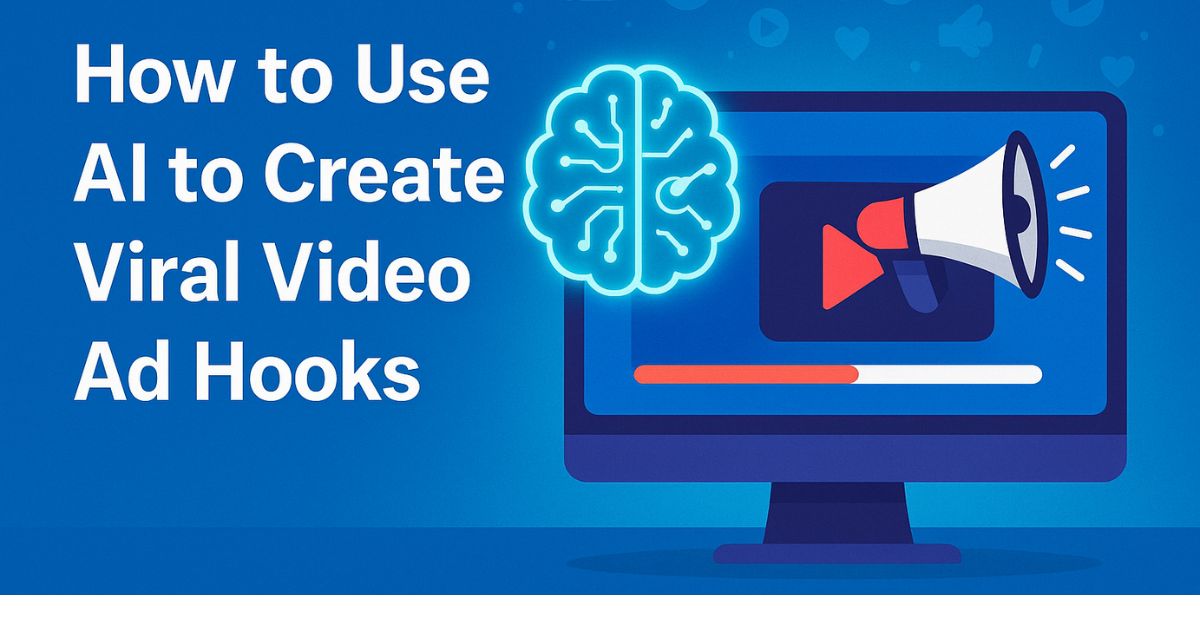If your video ad doesn’t hook someone in the first two seconds, it’s dead on arrival. That’s the truth. Attention spans are short, and competition is brutal. But here’s the good news—AI tools make it easy to create viral, scroll-stopping video hooks in minutes. Not hours. Not days. Fifteen minutes is all it takes when you follow the right process.
Let’s break it down step by step.
1. Understand What Makes a Hook Go Viral (2 minutes)
A viral video hook is like a punch to the brain—fast, unexpected, emotional. It gets people to stop scrolling and start watching. The best hooks hit one or more of these triggers:
- Emotion: Surprise, humor, shock, curiosity
- Curiosity: “You won’t believe what happened next…”
- Benefit-driven: “Here’s how I lost 10 lbs without dieting”
- Challenge or drama: “This might be the worst mistake I’ve ever made…”
If you understand what makes people tick, you can craft a hook that hits hard.
2. Choose Your AI Hook Generator (1 minute)
You don’t need to write from scratch. There are plenty of AI tools out there built for this exact purpose. Some generate just the hook. Others create full scripts or even entire video ads. Look for tools that let you plug in your product, audience, and tone—and then spit out several hook options instantly.
The goal here is speed. These tools give you a running start so you’re not staring at a blank screen.
3. Write a Simple Prompt for the AI (1 minute)
Keep your brief short but focused. One or two sentences max. Include your product, who it’s for, and the tone you want.
Example:
“Protein coffee for busy moms who want more energy, playful tone.”
Drop that into the AI, and you’ll get a bunch of hooks back in seconds.
4. Pick and Polish the Best Hook (2 minutes)
Now you’ve got a handful of hook options. Don’t just copy and paste—refine them. Here’s how:
- Cut fluff. Every word must earn its place.
- Add punch. Use numbers, power words, or tension.
- Personalize it. Mention something specific to your brand or audience.
Example:
Before: “This coffee changed my morning.”
After: “I stopped drinking $7 lattes when I found this $1 energy hack.”
Short, sharp, and loaded with curiosity.
5. Build the Rest of the Ad Script (3 minutes)
Once the hook’s in place, use AI again to help build the body of the ad. The formula is simple:
- Hook
- Introduce the problem
- Show the solution
- Highlight the result
- Call to action
Paste the hook and a product description into an AI writing tool. Ask it to generate a 3–5 sentence script. Then tweak it to sound more like you—more human, less robotic.
6. Create the Video with AI (4 minutes)
Now it’s time to bring that script to life. AI video tools can generate videos from text alone. Some offer avatars or voiceovers, others let you add product images and clips.
Workflow:
- Paste in your script.
- Choose a video style or template.
- Let the tool generate your video.
- Download or export the final cut.
This can take as little as 3–4 minutes, especially if you’re using pre-set visuals or stock assets.
7. Test Multiple Hook Versions (2 minutes)
Never bet everything on one hook. You’ve still got a couple minutes—use them to test. Generate two or three hook variations and plug them into the same script. Create separate video versions.
Then test them. Post to TikTok, YouTube Shorts, or run paid ads. Track which one gets the best engagement—views, watch time, clicks.
Let the numbers tell you which hook wins.
8. Refine and Repeat (5 minutes per day)
Here’s the real power move—turn this into a daily habit.
- Log which hooks work best: questions, stats, emotional stories, etc.
- Use that data to inform the next round.
- Build a swipe file of winners.
Every day you run this loop, your hooks get sharper. Your instincts get faster. Your content gets better.
Real-World Example: Quick, Crazy, Viral
A creative team needed a weird, unforgettable ad fast. Using AI, they scripted a surreal 30-second video—talking eggs, aliens, bizarre humor. It cost next to nothing, took just a few days, and racked up millions of views. The secret? Start with a bold hook, let AI do the heavy lifting, and keep it weird.
You can pull off the same thing on a smaller scale—15 minutes at a time.
Quick Summary: Viral Video Hook in 15 Minutes
Step Time Action
Understand hook psychology 2 min Learn what grabs people instantly
Pick an AI tool 1 min Use one that fits your workflow
Write a quick prompt 1 min Include product, audience, tone
Choose and tweak a hook 2 min Make it snappy, bold, personal
Generate the ad script 3 min Use AI to flesh it out fast
Create the video 4 min Build it using AI video tools
Test a few versions 2 min Let real data pick the winner
Repeat daily 5 min Sharpen your hooks over time
Total time: 15 minutes per hook. That’s all it takes to stay ahead.
Tips to Make It Stick
- Don’t overthink it: The first draft doesn’t need to be perfect—just get it out.
- Focus on emotion: What do you want people to feel in the first 3 seconds?
- Cut the fluff: Shorter is better. Sharper is better.
- Trust your gut: If a hook makes you stop scrolling, it’ll probably work.
Also—balance the AI’s speed with your own sense of what feels human. Tweak for tone. Add a little personality. That’s what makes content feel real.
Final Thoughts
You don’t need a big team or a Hollywood budget to make viral content. With the right tools and process, you can crank out strong, catchy video hooks every day. In 15 minutes flat. Just follow the formula: emotional hook, clear message, fast execution. Use AI for speed. Use your brain for polish. And watch your content go further, faster.
Conclusion
Creating viral video ad hooks with AI isn’t just possible—it’s smart, fast, and scalable. You’re not trying to reinvent the wheel every time. You’re building a repeatable system that delivers results. With a bit of practice, you’ll know exactly how to crank out high-performing hooks that stop thumbs and drive views.
Fifteen minutes. That’s all you need. Let AI handle the grunt work. You focus on making it






